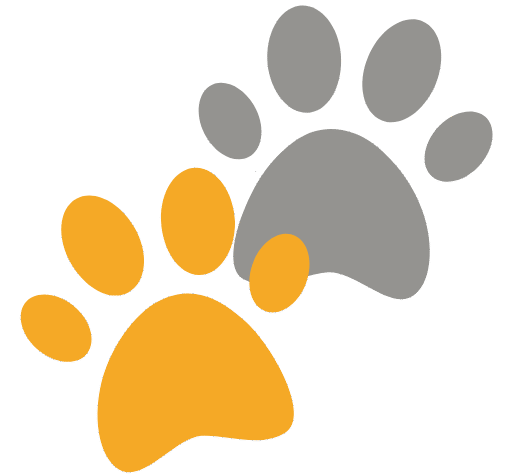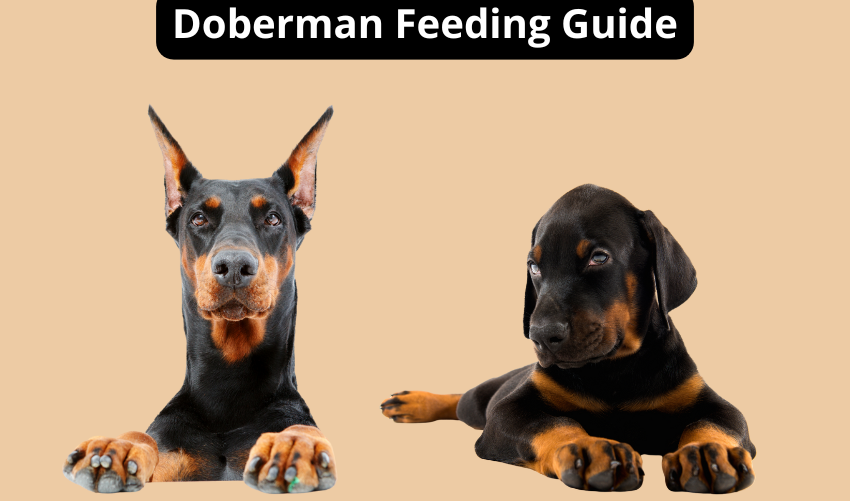This guide will help you navigate the world of Doberman nutrition. Overfeeding can lead to obesity, while underfeeding can cause malnutrition.
You will learn about the best food options, feeding schedules, and portion sizes. With the right information, you can ensure your Doberman thrives.
Understanding The Doberman’s Nutritional Needs
Understanding the Doberman’s nutritional needs is crucial for their overall health. A well-planned diet supports their energy, growth, and well-being.
Energy Requirements By Life Stage
Dobermans have different energy needs at various life stages. Puppies, adults, and seniors all require different amounts of food.
- Puppies: Rapid growth demands higher calories and protein. Puppies need about 1,000 to 1,500 calories daily.
- Adults: Moderate intake supports lean muscle and stamina. Adult Dobermans typically need 1,400 to 2,100 calories each day.
- Seniors: Lower energy needs – focus on joint support and digestion. Senior Dobermans require around 1,200 to 1,600 calories daily.
Adjust food amounts based on your Doberman’s activity level and health. Always consult your vet for personalized advice.
Nutrient Breakdown For Healthy Growth
Doberman require a balanced mix of nutrients for healthy growth. Each nutrient plays a vital role in their development.
- Protein: 25–30% from quality animal sources. Protein is essential for muscle growth and repair.
- Fat: 12–18% to fuel energy and maintain a shiny coat. Healthy fats provide energy and support skin health.
- Micronutrients: Balanced calcium and phosphorus are important for bone health. DHA supports brain development in puppies.
Avoid fillers and low-quality ingredients. Choose dog food with whole ingredients. Look for specific nutrients tailored to each life stage.
Why Dobermans Need High-Quality Protein And Fat
High-quality protein and fat are crucial for Dobermans. These nutrients help maintain a healthy lifestyle.
- Lean Muscles: Supports athletic build and daily activity. Quality protein helps dogs maintain muscle mass.
- Healthy Skin: Omega-3 and -6 fats reduce dryness and flaking. These fats promote a shiny coat and overall skin health.
- Stamina: Sustains energy levels for active lifestyles. Proper fat intake fuels their energy for play and exercise.
Feeding high-quality food ensures your Doberman stays active and healthy. Select brands known for their nutritional standards. Regularly monitor your dog’s weight and adjust food portions as needed.
Feeding Doberman Puppies: From Weaning To One Year
Feeding your Doberman puppy properly is essential for their growth and development. From weaning to one year, their dietary needs change significantly. Puppies require balanced nutrition to support their active lifestyles.
How Diet Changes Month By Month (6, 8, 10 Months & Beyond)
Your Doberman puppy’s diet evolves quickly during their first year. Here’s a breakdown of dietary changes at key milestones:
| Age | Feeding Schedule | Food Amount |
|---|---|---|
| 8–12 Weeks | 4 meals/day | 1.5–2 cups/day |
| 3–6 Months | 3 meals/day | 2–3.5 cups/day |
| 6 Months | 3 meals/day | 3 cups/day |
| 8 Months | 2 meals/day | 3.5 cups/day |
| 10–12 Months | 2 meals/day | 3–4 cups/day |
This table provides a general guideline for feeding your Doberman puppy. Remember that these are starting points, and individual needs can vary based on your puppy’s activity level, metabolism, and the specific food you choose.
How Much To Feed A Doberman Puppy Daily
Feeding your Doberman puppy the right amount is crucial for their health. Daily food intake depends on their age and activity level. Here’s a simple guide:
- 8–12 Weeks: 1.5–2 cups, split into 4 meals.
- 3–6 Months: 2–3.5 cups, across 3 meals.
- 6 Months: 3 cups, divided into 3 meals.
- 8 Months: 3.5 cups, now split into 2 meals.
- 10–12 Months: 3–4 cups, still in 2 meals.
Always choose high-quality puppy food. Look for options rich in protein and fat. Monitor your puppy’s weight regularly. Adjust portions based on their growth.
Best Food Types For Doberman Puppies: Kibble, Raw & Wet
The right food types play a crucial role in Doberman growth and overall health. Each type has unique benefits. Understanding these can help you make informed choices for your Doberman puppy.
Purina Pro Plan Large Breed Puppy Chicken & Rice Formula
Purina Pro Plan is formulated specifically for large breed puppies. This kibble provides balanced nutrition to support their growth. It contains real chicken as the first ingredient, ensuring high-quality protein.
Key benefits include:
- Supports joint health and overall development.
- Rich in antioxidants for a strong immune system.
- Includes DHA from fish oil for brain and vision development.
This kibble is designed for large breed puppies. The size and shape of the kibble promote healthy chewing. This helps reduce the risk of bloat.

Stella & Chewy’s Freeze-Dried Raw Patties
Stella & Chewy’s offers convenient freeze-dried raw food. This option gives the benefits of raw feeding without the mess. Each patty contains high-quality meat sourced from trusted suppliers.
Benefits of Stella & Chewy’s include:
- Supports healthy digestion and strong teeth.
- Packed with vitamins and minerals for overall health.
- Variety of proteins available to suit picky eaters.
These patties are easy to prepare. Simply add water to rehydrate them. This makes feeding time quick and simple.

Royal Canin Veterinary Diet Gastrointestinal Low Fat Canned Dog Food
Royal Canin Veterinary Diet Gastrointestinal is a highly digestible wet food. This option is suitable for dogs with sensitive stomachs. It helps manage digestive health while providing essential nutrients.
Key features include:
- Low fat content to support healthy weight management.
- Rich in electrolytes and B vitamins for recovery.
- Supports a balanced gut microbiome.
This canned food is easy to mix with kibble or serve alone. It provides hydration, which is vital for puppies.

Transitioning To Adult Dog Food
This guide helps you understand the signs that indicate it’s time to make the switch, how to do it safely, and how to adjust food quantities afterward.
Signs Your Doberman Is Ready To Switch From Puppy Food
Knowing when to transition your Doberman from puppy food is crucial. Watch for these key signs:
- Slower Growth: Typically around 12–14 months, your Doberman’s growth rate slows down.
- Stable Weight: There should be no rapid gain or loss in weight.
- Increased Activity: Your dog’s needs shift toward endurance and maintenance.
These signs indicate that your Doberman is ready for adult food. A gradual transition is essential for their health. A sudden switch can upset their stomach.
How To Make The Transition Smooth And Safe
Making the switch from puppy food to adult food should be done carefully. Follow these steps for a smooth transition:
- 7–10 Day Mix: Gradually blend new food into the old. Start with a small amount of adult food mixed with puppy food.
- Watch Digestion: Monitor your dog’s stool and appetite. Changes can indicate how well they are adjusting.
- Consult Your Vet: If unsure, talk to your veterinarian for personalized advice.
Gradual mixing helps prevent digestive issues. A sudden change can cause diarrhea or vomiting. Keep an eye on your Doberman during this time.
Adjusting Food Quantities After The Switch
After transitioning to adult dog food, adjusting food quantities is essential. Follow these guidelines:
- Reduce Calories: Adult formulas are less calorie-dense compared to puppy food.
- Monitor Body Condition: Aim for a lean body with a visible waist. This indicates healthy weight.
- Avoid Overfeeding: Prevent joint strain and obesity by not overfeeding.
- Adjust by Activity: Working dogs may need up to 25% more food based on their activity level.
Regularly check your Doberman’s weight. Adjust portions as needed. This keeps your dog healthy and full of energy.
How Much To Feed An Adult Doberman Each Day
Adult Dobermans need a balanced diet that matches their weight and activity level. Knowing how much to feed them each day helps maintain their energy and overall well-being.
Daily Food Amounts Based On Weight And Activity
The daily food amount for an adult Doberman varies. It depends on their weight and activity level. Below is a guideline for daily food amounts:
| Weight Category | Daily Food Amount |
|---|---|
| Standard Adult (70–90 lbs) | 3–5 cups/day depending on energy. |
| Highly Active Dogs | 5.5–6 cups/day. |
| Low Activity Dogs | 2.5–3 cups/day. |
Consider the following points:
- Measure food based on the dog’s weight.
- Monitor their energy levels.
- Adjust portions for changes in activity.
Feeding the right amount helps prevent obesity. Obesity leads to health problems. Regular portion checks ensure your Doberman stays fit and healthy.
Portioning For Working Dogs Vs. Couch Companions
Working dogs and couch companions have different needs. Working Dobermans often require more food. They need higher fat and protein. This helps sustain their energy for long hours of work. Consider these feeding guidelines:
- Working Dogs: More calories and protein.
- House Pets: A balanced maintenance formula works well.
- Seniors: Controlled calories with joint support.
Portion sizes differ based on daily activity. Working dogs may eat more than the average Doberman. House pets need stable portions to maintain weight. A consistent feeding routine helps manage their diet.
Monitoring Weight And Adjusting Portions
Monitoring your Doberman’s weight is essential. Regular check-ins help keep their weight in check. Aim for weekly check-ins. Feel their ribs and check their waist. This helps assess if they are at a healthy weight.
Keep track of treats. Treats should be under 10% of daily intake. This prevents excess calories. Adjust portions seasonally. In colder weather, dogs burn more energy. Increase their food slightly to match their needs.
Regular monitoring helps keep your Doberman healthy. Adjust their diet based on activity, age, and weight. A well-fed Doberman is a happy Doberman.
Feeding Schedule And Mealtime Routine
A good feeding schedule and mealtime routine help maintain their health. Proper timing and portions keep them energetic and happy.
How Often To Feed A Doberman At Each Age
The feeding frequency for Dobermans changes as they grow. Puppies need more meals to support their rapid growth. Here’s a breakdown of feeding schedules by age:
| Age Group | Meals per Day |
|---|---|
| Puppies (up to 6 months) | 3–4 meals/day |
| Adolescents (6 months to 1 year) | 2–3 meals/day |
| Adults (1 year and older) | 2 meals/day |
Feeding your Doberman at the same times daily is important. It reduces anxiety and improves metabolism.
Creating A Consistent Routine That Supports Digestion
Establishing a consistent feeding routine is key for Dobermans. A regular schedule helps their digestion. Here are some helpful tips:
- Feed at the same times each day.
- Create a quiet space for meals.
- Avoid exercise before and after meals.
A quiet space reduces gulping and food aggression. It helps your dog focus on eating. Avoiding exercise around mealtime lowers the risk of bloat.
After meals, ensure your Doberman rests for 45–60 minutes. This allows for better digestion and comfort. Splitting portions into smaller amounts can also support metabolism and reduce hunger.
Hydration And Meal Timing For Active Dobermans
Active Dobermans need proper hydration. Always provide fresh water, especially after activity. Timing meals is essential for their health:
- Water should be available at all times.
- Feed meals at set intervals.
- Adjust meal portions based on activity levels.
For active Dobermans, plan meals around their exercise. This helps maintain energy levels. If they eat right before exercise, it can lead to discomfort.


